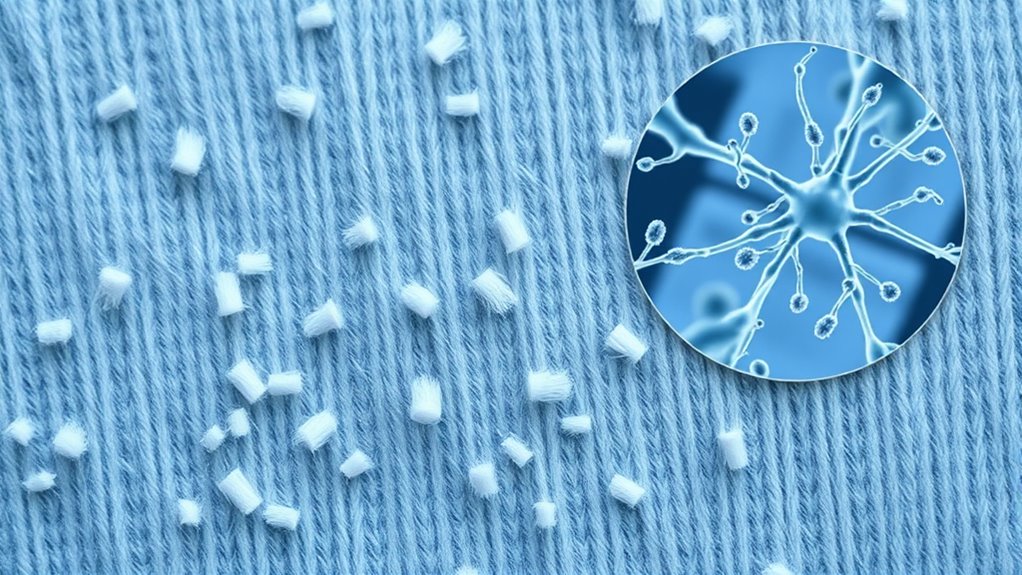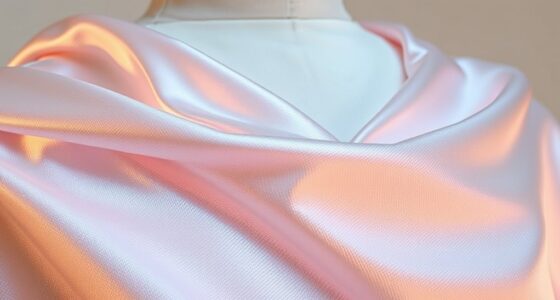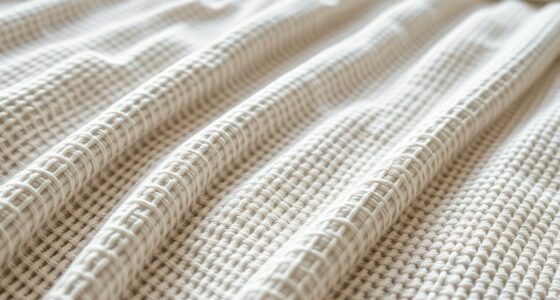Fabric pilling happens when fibers break and tangle, creating those tiny fuzz balls on your clothes. Harsh detergents, high temperatures, and frequent washing speed up this process, especially with natural fibers like wool and cotton. Luckily, science is stepping in with anti-pilling treatments and stronger fiber blends to make clothes last longer. If you want to learn how advanced solutions are fighting pilling and keeping textiles looking new, keep going.
Key Takeaways
- Fabric pilling results from fiber breakage and entanglement caused by wear, washing, and textile degradation.
- Synthetic fibers like polyester resist pilling better than natural fibers such as wool or cotton.
- Scientific advancements include anti-pilling treatments and fiber reinforcement to prolong fabric integrity.
- Proper garment care, like washing inside out and avoiding high heat, reduces fiber wear and pilling.
- Innovations in fabric blends and finishes aim to slow degradation and maintain apparel appearance longer.

Have you ever noticed tiny balls forming on your clothing after a few wears? Those little fuzz balls, known as pills, are a common annoyance that can make even your favorite garments look worn out. Pilling occurs when fibers on the fabric’s surface break loose and tangle together, creating those fuzzy spots. While it might seem like a minor cosmetic issue, pilling actually reveals a lot about the fabric’s fiber durability and how textile degradation happens over time. Understanding what causes pills helps you choose better fabrics and care for your clothes more effectively.
At the core of fabric pilling is fiber durability—the ability of a fiber to withstand wear and tear without breaking or fraying. Synthetic fibers like polyester or nylon tend to be more resistant to pilling because they’re stronger and less prone to breakage. Natural fibers, such as wool or cotton, can be more susceptible, especially if they are of lower quality or poorly processed. When fibers break or weaken, tiny loose ends form, which then get tangled with other fibers and create pills. Over time, repeated washing and wearing accelerate this process, leading to more visible pills. This is where textile degradation comes into play. With each wash, fibers can weaken or become damaged, especially if you use harsh detergents, high temperatures, or abrasive cycles. Such factors speed up fiber breakage and, consequently, pilling.
Fiber durability determines pilling; weaker fibers break, forming pills faster over time.
Scientists and textile engineers are actively developing solutions to combat pilling by improving fiber quality and fabric construction. Advances in textile science now include treatments that reinforce fiber strength and reduce fiber breakage. For example, some fabrics are coated with anti-pilling finishes that help fibers stay intact longer. Researchers are also exploring new synthetic blends that combine the best qualities of natural and synthetic fibers, offering both comfort and enhanced durability. These innovations aim to slow the process of textile degradation, allowing garments to maintain their appearance and integrity for a longer period. Additionally, understanding the fiber properties and how they influence pilling can help consumers make informed choices when selecting clothing.
While science is making strides in reducing pilling, proper care remains essential. Washing clothes inside out, using gentle cycles, and avoiding high heat can considerably extend the lifespan of your garments. Choosing fabrics with high fiber durability from the start means fewer pills and less textile degradation over time. So, next time you see those tiny fuzz balls forming on your sweater or shirt, remember that they’re a sign of fiber wear and tear. With smarter fabric choices and better maintenance, you can keep your clothes looking newer, longer.
Frequently Asked Questions
Can Fabric Pilling Be Completely Prevented?
You can’t completely prevent fabric pilling, but fiber treatments and chemical agents can markedly reduce it. When you choose fabrics with advanced treatments, they’re less likely to develop pills over time. These treatments strengthen fibers and minimize fuzz shedding. While no method guarantees total prevention, using high-quality materials and proper care can keep your clothes looking newer longer, fighting pilling more effectively.
Do Certain Fabrics Resist Pilling Better Than Others?
Yes, some fabrics resist pilling better than others. Fabrics with tighter weaves or higher polyester content tend to be more resistant because their fabric composition makes fibers less likely to loosen. Additionally, advanced manufacturing processes, like using smoother fibers or treatments, help reduce pilling. You’ll find that choosing fabrics with these features can keep your clothes looking newer longer and minimize those annoying pills.
How Does Fabric Pilling Affect Clothing Durability?
Imagine your clothing as a sturdy castle, but fiber pilling acts like tiny battering rams, weakening the walls over time. Pilling indicates the breakdown of fiber strength, which directly impacts garment longevity. As pills form, they create weak spots, reducing durability and causing your clothes to wear out faster. To keep your wardrobe resilient, choosing fabrics with high fiber strength helps prevent pilling and extends the life of your garments.
Are There Eco-Friendly Solutions to Reduce Pilling?
You can reduce pilling with eco-friendly solutions like using sustainable fibers, which are naturally more resistant to pilling. Additionally, look for clothing treated with eco-friendly treatments designed to minimize pilling, helping your garments last longer. By choosing these options, you’re making an environmentally conscious choice that also preserves your clothing’s quality, so you get more wear out of your wardrobe while supporting sustainable fashion practices.
Does Washing Method Influence Pilling Severity?
Imagine your clothes having a wild party in the washing machine—fabric softeners and all. You’ll find that your washing method really influences pilling severity. Use gentle settings, skip fabric softeners, and turn clothes inside out. This reduces friction and fiber breakage, preventing those pesky pills. So, next time, don’t just toss your wardrobe in; treat it with care, or risk turning your favorite shirt into a fabric fuzzball!
Conclusion
Now that you understand what causes fabric pilling and how science fights it, you see the battle isn’t just in the fibers. It’s in your wardrobe, your confidence, your choices. The fight against pilling isn’t just about tougher fabrics—it’s about smarter technology, innovation, and care. So, next time you pick out that cozy sweater, remember: science is working behind the scenes to keep it looking new. That’s the real fabric of progress.










